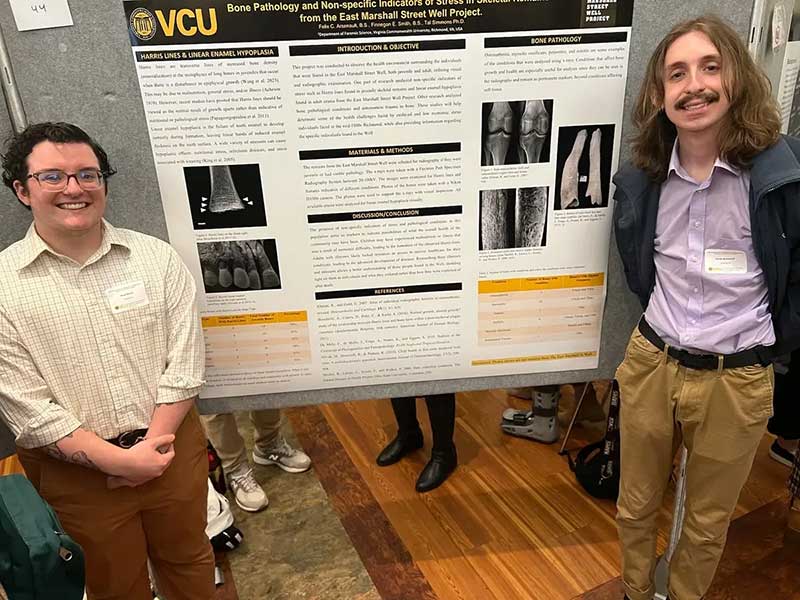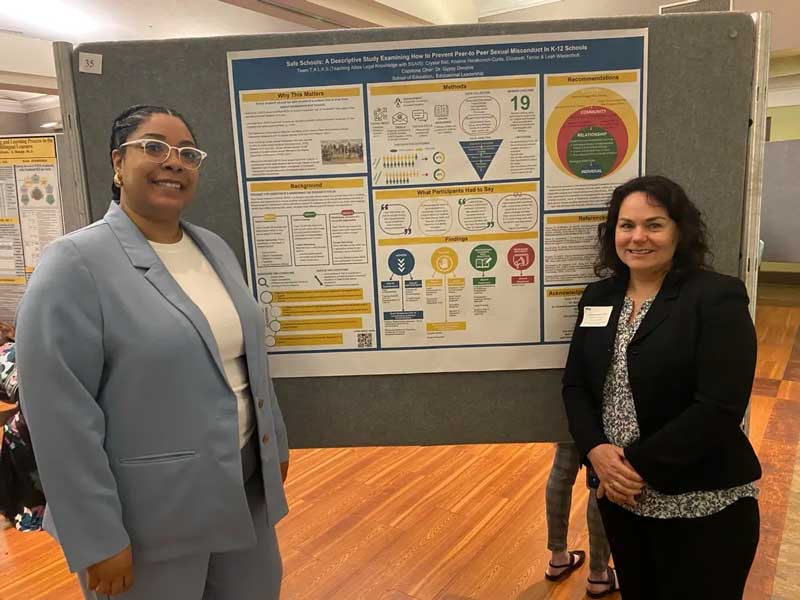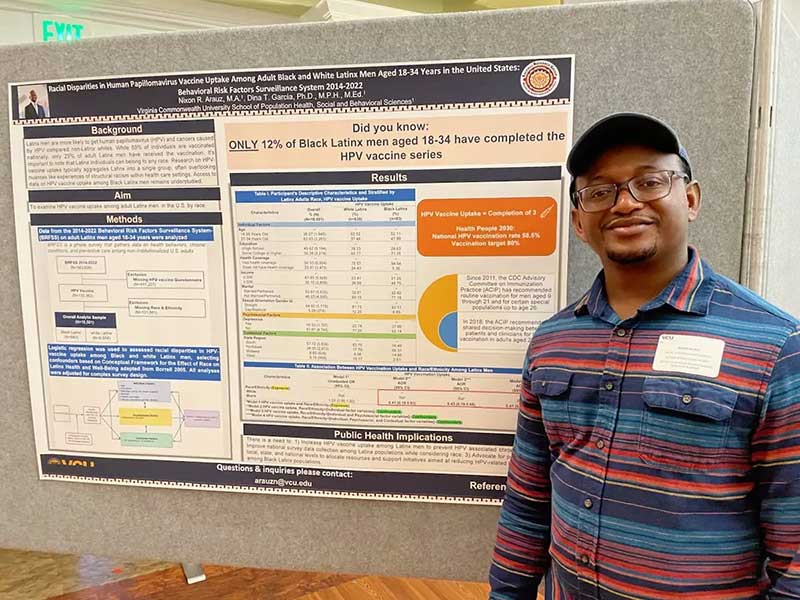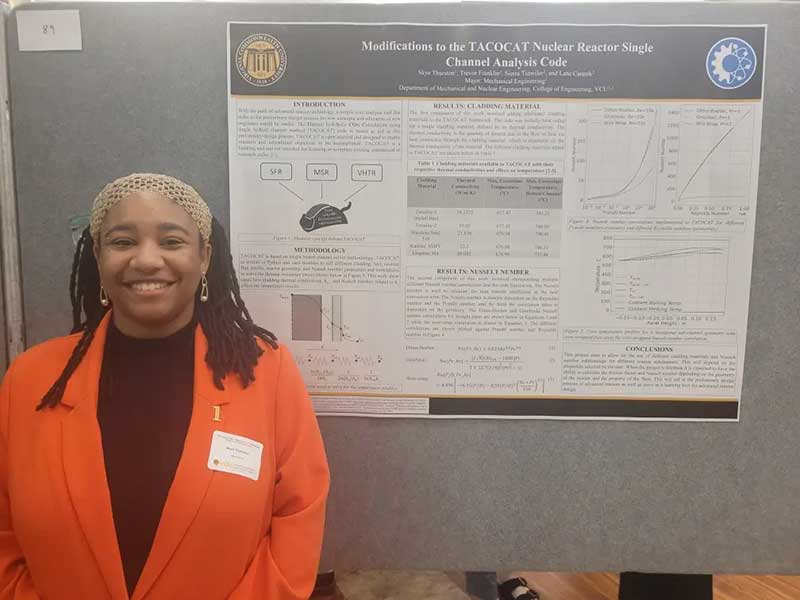The past, present and future came together in meaningful ways last month as academic achievement, diversity and historical reckoning were literally on display at Virginia Commonwealth University.
The 16th annual Poster Symposium for Undergraduate Research and Creativity, held April 25 at University Student Commons, spotlighted how VCU’s younger students are advancing knowledge in many fields – and how the university is prioritizing research as part of the undergraduate experience. A day earlier, the 27th annual Graduate Student Research Symposium was held, and together, the sessions served as a centerpiece of Research Weeks 2024 – a collection of more than 40 events highlighting VCU’s renowned and growing research enterprise.
At the undergraduate poster symposium, 350 students displayed and explained the findings of their recent investigations.
“What really sticks out to me is the interdisciplinarity of the projects this year,” said Herb Hill, Ed.D., VCU’s director of undergraduate research and creative inquiry in the Office of the Provost. “Having been doing this work for the past 15 years, you hear university leaderships talk about how important interdisciplinary research is, and that’s happening now. That’s filtered down to the undergraduate level, which is the whole point.”
Felix Arsenault, a senior majoring in forensic science and chemistry, focused on a project with special resonance at VCU: He analyzed pathology and stress indicators of bones from the East Marshall Street Well Project, which prioritizes the study, memorialization and reburial of the skeletal remains. They came primarily from individuals of African descent whose bodies were used as medical cadavers in the 19th century and then discarded into a well, which was uncovered on the university’s MCV Campus in 1994.

Arsenault, along with fellow senior and forensic science major Finnegan Smith, relished the chance to practice technical skills and prepare for humanitarian work in the sensitive field of forensic anthropology.
“We found that quite a few bones had diseases,” Arsenault said, noting osteoarthritis in knee joints as well as periostitis, which is inflammation of connective tissue surrounding bone. “There was a lot of postmortem damage, but that’s not indicative of the health environment. That’s indicative of how the remains were treated after death.”
Arsenault and Smith said there can be a lot of emotional weight in their research area. “But we have a lot of honor in working with these remains,” Arsenault said.
Cyrus Rosalu, a senior majoring in anthropology, explored another piece of Richmond history: the Pine Camp Tuberculosis Hospital, which served Black residents. The research, which included visiting medical library archives at the University of Virginia, revealed how Black patients received subpar treatment compared with white patients suffering from the same lung disease.
“There was a lot of systematic mistreatment in the hospitals – overcrowding, waitlisting, needed repairs and a lack of nurses,” Rosalu said, adding that “even though this was expected from prior knowledge, it was still disappointing to see that this was the reality.”
But there were pleasant surprises, too. “We were able to find the evidence of Black history of people who were working there, such as the nurse Elizabeth Gaiters” – who was referred to only as “the Black nurse” in archival findings, he said. Additional sleuthing led to annual reports about her and articles that spotlighted her dedication.
“We are finding the history, and we want to recognize that even during this time, it’s not just Black patients being mistreated but also Black medical professionals who should be recognized for their hard work during this time,” Rosalu said.

Other undergraduates delved into complex scientific pursuits. Skye Thurston, a senior majoring in mechanical engineering and physics, stood by her poster that detailed how heat will function and travel through nuclear reactors – a project whose coding component could propel her on a path to graduate school. Lucas Codispoti, a senior majoring in psychology and biology, led a mass spectrometry project using Chinese hamster ovary cells to explore Niemann-Pick disease type C, a rare genetic disorder that can arise in childhood.
Brock Lodato, a junior majoring in biomedical engineering, looked at two cell types in laryngeal cancer tumors and how they behaved differently to treatment with vitamin D. He emphasized the personal connection of research.
“I do research because I strive to know things. I was diagnosed in high school with type 1 diabetes, and they couldn’t tell me why. That irked me. I do research to find my ‘why,’” Lodato said. “I do that to learn more and expand the human knowledge of our own bodies.”
A day earlier, VCU graduate students were in the spotlight, displaying posters in disciplines ranging from social sciences to STEM, education to ecology, and public health to physics. Their symposium was organized by Erin Brown, Ph.D., director of professional development for the Graduate School.
Morgan Jackson, a doctoral candidate in applied mathematics, analyzed statistics of dengue virus outbreaks in temperate Argentina. Lara LoBrutto, pursuing a Ph.D. in counseling psychology, evaluated “the role of interoceptive awareness in insomnia and across the sleep health spectrum.” Crystal Bell and Kristine Herakovich-Curtis, who are working toward doctorates in educational leadership, collaborated on a project evaluating a nonprofit’s effectiveness in its efforts to stop sexual assault.

Nixon Arauz, a doctoral candidate in social and behavioral sciences, researched racial disparities in the cancer-preventing human papillomavirus vaccine among Black and white Latinx men ages 18-34.
“Only 12% of Black Latinx men ages 18-34 have completed the HPV vaccine series” – a much lower figure than for other groups, said Arauz, who used survey data from the federal Behavioral Risk Factor Surveillance System for his project.
He said his work is crucial because Latinos can be of any race, and research on HPV vaccine typically aggregates Latinos into one group. He added that structural racism in health care settings has to be accounted for.
With support from VCU faculty, including for his poster presentation, Arauz looks forward to securing a postdoctoral research fellowship or federal position. He also articulated a larger goal, one that matches the spirit of VCU’s research enterprise – whether for students, faculty or others at any level: “Contribute to further improve the health of our collective American society.”
